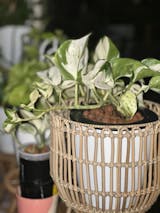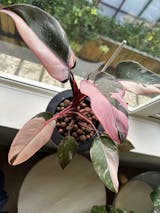Egmont Leca - Expanded Hydro Clay Balls - 2 litre bag
- Regular Price
- $14.99
- Sale Price
- $14.99
- Regular Price
- Unit Price
- Translation missing: en.general.accessibility.unit_price_separator
What is Leca?
LECA stands for Lightweight Expanded Clay Aggregate, also called hydro balls or clay balls. They are balls of clay that have been baked so they expand (I think of them like popcorn, or Aero Bar chocolate). Once they've absorbed water, they expand a little more, but retain a super porous texture full of tiny air pockets. Unlike other substrates that absorb 2 to 4 times their weight in water, Leca absorbs about 30% their weight in water, making them a great substrate for plants who dislike being over-watered.
How much Leca is in the bag?
Egmont Leca comes in a 2 litre bag and is very light for its size. One bag measures about 33cms long x 25cms wide x 5cms and contains about 1kg of Leca, give or take 500 grams or so (remember it's measured by volume not weight, so weight varies bag to bag). One bag fills around 25 x mini pots, or around 4 to 5 x 11cm nursery pots, based on TEKU clear pots. Of course this depends on how full you want your pot, and how much room the plant's roots need. Leca doesn't go off so extra can be stored for later. Ball sizes vary from around 1cm to 1.5cms round'ish.
Why grow plants in Leca instead of soil?
Leca makes it easy to 'wet and forget'. Far less risk of root rot. Chances of pests are significantly reduced (especially Fungus Gnats and Spider Mites). Checking plant health is super easy. But Leca isn't totally 'wet and forget'. There is a still maintenance required. You also need to fertilise. Leca is a great propagation medium too. More about set-up, maintenance and Leca-friendly fertiliser below, plus learn even more about Leca here >
Do you have to use Leca by itself?
You can, and many do, use Leca mixed in with potting mix or create a DIY mix, to add drainage, increase oxygen and even out water distribution.
Is Leca single-use?
Unlike most potting mixes, which decompose and compact over time and are thrown out when you repot; Leca is reusable, over and over.
How do you prepare Leca?
Leca can start out very dusty! Always rinse and soak before use. Never put plants into very dry Leca.
STEP 1: RINSE
Give new Leca a really good rinse until water runs clear. Best to do outside so the clay particles end up in your lawn, not inside where the silt could block your sink! Pro tip: Put Leca in a mesh laundry bag or fish tank media bag and use your garden hose.
STEP 2: SOAK
Once rinsed, soak for 24 hours, just in tap water is fine. You can either soak for 48 hours / 2 days, then pot up, or dump out the water from the first soak, and soak in fresh water again for another 24 hours (I prefer the double-soak or triple-soak method below). Pro tip: You can prep Leca in advance. If you won't use it all right away, just store the rest somewhere cool and dry until needed, and give it a 24 hour soak again before use later.
STEP 3: NUTRIENT SOAK (OPTIONAL)
A 3rd soak is optional (so is the 2nd soak really), but for valuable plants, I recommend the triple-soak method. For this 3rd soak, ideally use filtered water, or distilled or RO water if you have it. Add some nutrients (see below), and soak in nutrient solution for a further 24 hours. Discard the nutrient solution, and you're ready to pot up.
What nutrients do you soak Leca in?
If you do the triple-soak method, the third soak can be in nutrient solution. I use GT CCS root fertiliser, as it has calcium and magnesium included, is free of urea and chlorides (reducing mineral salt build-up for reduced risk of fertiliser burn), and is complete and balanced, formulated for use in hydro and semi-hydro (similar to the popular KLN + Cal/Mag soak popular overseas).
Can all plants be grown in Leca?
Like moving from water to soil, and soil to water, some plants adjust better than others to the shift from soil to Leca (shifting from water to Leca is the easiest transition). Some plants go through transplant shock, and may lose some roots before they adjust, called 'root melt'.
Plant families that tend to do great in Leca include: Monstera, Sansevieria, ZZ Plants, Alocasia, Spider Plants, Synognium and Begonia. In general, plants that do well in Leca tend to share the same characteristics: they like to dry out before watering, tend to grow roots quickly, are hardy enough to cope with being handled often, and prefer airy, oxygen-rich substrates.
What fertiliser should you use with Leca?
Leca provides no nutrients. Serious hobbyists might buy nutrients separately and create their own mix, however I prefer a simpler method of using an all-in-one hydro fertiliser. My current go-to is GT Foliage Focus or GT Complete Focus. Both include calcium and magnesium. Both are free of urea and chlorides for less risk of fertiliser burn. Both are formulated for hydro and semi-hydro. Both are complete and balanced.
Find out more about prepping and using Leca, suitable pots, wick watering vs submerged, how to prep your plants for Leca and more > PS: I'll also email you a link to that full Leca guide after you order - Anna :)




